international business -1
国际商务英语(英文版)

International Business English国际商务英语Lesson 1 International Business第一课国际商务*International business refers to transaction between parties from different countries. Sometimes business across the borders of different customs areas of the same country is also regarded as import and export, such as business between Hong Kong and Taiwan.*International business involves more factors and thus is more complicated than domestic business. The following are some major differences between the two.1). The countries involved often have different legal systems, and one or more parties will have to adjust themselves to operate in compliance with the foreign law.2). Different counties usually use different currencies and the parties concerned will have to decide which currency to use and do everything necessary as regards conversion etc. Uncertainties and even risks are often involved in the use of a foreign currency.3).Cultural differences including language, customs, traditions, religion, value, behaviour etc. often constitute challenges and even traps for people engaged in international business.4). Countries vary in natural and economic conditions and may have different policies towards foreign trade and investment, making international business more complex than domestic business.*With the development of economic globalisation, few people or companies can completely stay away from international business. Some knowledge in this respect is necessary both for the benefit of enterprises and personal advancement.*International business first took the form of commodity trade, i.e. exporting and importing goods produced or manufactured in one country for consumption or resale in another. This form of trade is also referred to as visible trade. Later a different kind of trade in the form of transportation, communication, banking, insurance, consulting, information etc. gradually became more and more important. This type of trade is called invisible trade. Today, the contribution of service industries of the developed countries constitutes over 60% of their gross domestic products and account for an increasing proportion of world trade. *Another important form of international business is supplying capital by residents of one country to another, known as international investments. Such investments can be classified into two categories. The first kindof investments, foreign direct investments or FDI for short is made for returns through controlling the enterprises or assets invested in in a host country.*The host country is a foreign country where the investor operates, while the country where the headquarters of the investor is located is called the home country. The second kind of investment, portfolio investment, refers to purchases of foreign financial assets for a purpose other than controlling. Such financial assets may be stocks, bonds or certificates of deposit.Stocks are also called capital stocks or bonds. Bonds are papers issued by a government or a firm with promise to pay back the money lent or invested together with interest. The maturity period of a bond is at least one year, often longer, for example five, or even ten years. Certificates of deposit generally involve large amounts, say 25 thousand US dollars *Besides trade and investment, international licensing and franchising are sometimes taken as a means of entering a foreign market. In licensing, a firm leases the right to use its intellectual property to a firm in another country. Such intellectual property may be trademarks, brand names, patents, copyrights or technology. Firms choose licensing because they do not have to make cash payments to start business, and can simply receive income in the form of royaltyBesides, they can benefit from locational advantages of foreign operation without any obligations in ownership or management. The use of licensing is particularly encouraged by high customs duty and non-tariff barriers on the part of the host country. However it is not advisable to use licensing in countries with weak intellectual property protection since the licensor may have difficulty in enforcing licensing agreement.*Franchising can be regarded as a special form of licensing. Under franchising, a firm, called the franchisee, is allowed to operate in the name of another, called the franchiser who provides the former with trademarks, brand names, logos, and operating techniques for royalty. In comparison with the relation between the licenser and the licensee, the franchiser has more control over and provides more support for the franchisee.*The franchiser can develop internationally and gain access to useful information about the local market with little risk and cost, and the franchisee can easily get into a business with established products or services. Franchising is fairly popular especially in hotel and restaurant business.*Other forms for participating in international business are management contract, contract manufacturing, and turnkey project.*Under a management contract, one company offers managerial or other specialized services to another within a particular period for a flat payment or a percentage of the relevant business volume. Sometimes bonusesbased on profitability or sales growth are also specified in management contracts.Government policies often have a lot to do with management contracts. When a government forbids foreign ownership in certain industries it considers to be of strategic importance but lacks the expertise for operation, management contracts may be a practical choice enabling a foreign company to operate in the industry without owning the assets*By contract manufacturing, a firm can concentrate on their strongest part in the value chain, e.g. marketing, while contracting with foreign companies for the manufacture of their products. Such firms can reduce the amount of their resources devoted to manufacture and benefit from location advantages from production in host countries. However, loss of control over the production process may give rise to problems in respect of quality and time of delivery.*For an international turnkey project, a firm signs a contract with a foreign purchaser and undertakes all the designing, contracting and facility equipping before handing it over to the latter upon completion. Such projects are often large and complex and take a long period to complete. Payment for a turnkey project may be made at fixed total price or on a cost plus basis. The latter way of payment shifts the burden of possible additional cost over the original budget onto the purchaser *BOT is a popular variant of the turnkey project where B stands for Build, O for operate and T for transfer. For a BOT project, a firm operate a facility for a period of time after building it up before finally transferring it to a foreign company. Making profit from operating the project for a period is the major difference between BOT and the common turnkey project. Needless to say, the contractor has to bear the financial and other risks that may occur in the period of operation.*Some Words and Expressionscustoms area 关税区in compliance with 遵从,遵照conversion n.货币兑换visible trade 有形贸易resale n.转售invisible trade 无形贸易gross domestic product 国内生产总值for short 缩写为account for 占……比例headquarters n.总部trap n.陷阱,圈套portfolio investment 证券投资stocks n.股票bonds n.债券maturity n.(票据等)到期,到期日certificate of deposit 大额存单other than 而不是licensing n.许可经营franchising n.特许经营n.商标advisable adj.可行的,适当的patent n.专利royalty n.专利使用费,许可使用费,版税copyright n.版权licensor n.给予许可的人licensee n.接受许可的人franchiser n.给予特许的人franchisee n.接受特许的人logo n.标识,标记management contract 管理合同expertise n.专门知识bonus n.红利,奖金,津贴flat adj.一律的,无变动的contract manufacturing 承包生产value chain 价值链turnkey project 交钥匙工程BOT(Build, Operate, Transfer)建设,经营,移交Stand for 表示,代表variant n.变形,变体Lesson twoIncome Level and the World Market第二课收入水平和世界市场This lesson discusses the relation between the income level and the market potential, and the features of high income, middle income and low income markets.Special analyses are made on Triad, i.e. the markets of North America,European Union and Japan, as well as other markets that are closely related with China.The first two paragraphs mainly deal with GNP and GDP, two important concepts usedto indicate the total size of an economy. GDP, Gross Domestic Product, stresses the place of production while GNP, Gross National Product, on the ownership of production factors.GDP is used by most countries now where as GNP was more popular before the 1990s. The actual figures of a country’s GNP and GDP are, however, quite similar in most cases and we can use whichever figure that is available.TEXT:In assessing the potential of a market, people often look at its income level since it provides clues about the purchasing power of its residents. The concepts national income and national product have roughly the same value and can be used interchangeably if our interest is in their sum total which is measured as the market value of the total output of goods and services of an economy in a given period, usually a year. The differenceis only in their emphasis. The former stresses the income generated by turning out the products while the latter, the value of the product s themselves. Gross National Product, GNP, and Gross Domestic Product, GDP, are two important concepts used to indicate a country’s total income. GNP refers to the market value of goods and services produced by the property and labor owned by the residents of an economy. This term was used by most governments before the 1990s国民生产总值(GNP)是最重要的宏观经济指标,它是指一个国家地区的国民经济在一定时期(一般1年)内以货币表现的全部最终产品(含货物和服务)价值的总和。
International BusinessPPT课件

Invoice
A detailed list of goods shipped or services rendered, with
an account of all costs
Shipping documents
Documents that an exporter receives from the shipping
Import and export trading plays a significant role in international business.
2020/10/13
2
International trade refers to the exchange of goods or services between different countries or area.
2020/10/13
7
In the meantime, global sourcing is ensuring that the import and export supplier choices are at the top of their market, and making sure that the talent contained within the business is at the highest standard.
CIF
Price includes Cost, Insurance, Freight to a named port of destination in the
buyer’s cቤተ መጻሕፍቲ ባይዱuntry.
CIP
Price includes cost of goods, Carriage (freight), and Insurance Paid by
国际商务谈判Chapter1InternationalBusinessNegotiation.ppt
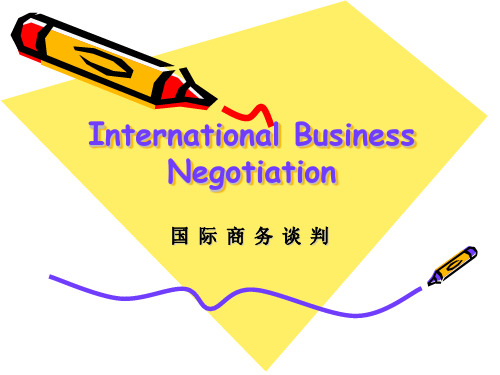
国际商务谈判
Chapter 1 Fundamentals of International Business Negotiating
第一章 国际商务谈判概述
• 1.1 Concepts and principles of negotiation
• As the stakes in some of these negotiations are not so high, people need not have to get preplans for the process and the outcome. There are other cases like international business negotiations in which the stakes are too high to be ignored, people have to be more cautious.
Characteristics of business negotiation
• Some of the characteristics of business negotiation include:
• ① Negotiation is at the heart of every transaction and, for the most part, it comes down to the interaction between two sides with a common goal (profits) but divergent methods.
• In negotiations, both parties should know: • a. why they negotiate • b. who they negotiate with • c. what they negotiate about • d. where they negotiate • e. when they negotiate • f. how they negotiate
英语国际商务合同5篇

英语国际商务合同5篇篇1International Business ContractI. IntroductionInternational business contracts play a significant role in the global economy as they establish the terms and conditions under which business transactions are conducted between parties from different countries. These contracts provide a legal framework for ensuring that both parties fulfill their obligations and protect their rights. This document outlines the key components of an international business contract and discusses the importance of drafting a comprehensive and well-defined contract.II. Key Components of an International Business Contract1. Parties: The contract should clearly identify the parties involved in the agreement, including their legal names, addresses, and contact information. It is important to accurately identify the parties to avoid confusion and disputes in the future.2. Scope of Work: The contract should specify the nature of the business transaction, including the products or services to be provided, the timelines for delivery, and the pricing terms. It is essential to outline the scope of work to ensure that both parties have a clear understanding of their responsibilities.3. Terms and Conditions: The contract should include terms and conditions that govern the rights and obligations of both parties. This may include payment terms, warranties, dispute resolution mechanisms, and termination clauses. It is important to carefully draft these provisions to protect the interests of both parties.4. Governing Law: The contract should specify the governing law that will apply in case of disputes between the parties. This is particularly important in international business contracts, where parties from different countries may be subject to different legal systems. The governing law clause helps to provide clarity and consistency in the interpretation of the contract.5. Arbitration Clause: International business contracts often include an arbitration clause, which outlines the process for resolving disputes outside of the court system. Arbitration is a common method of dispute resolution in international business contracts as it is often faster and more cost-effective thantraditional litigation. The arbitration clause should specify the rules and procedures that will govern the arbitration process.III. Importance of a Well-Defined ContractA well-defined international business contract is essential for establishing a solid foundation for a successful business relationship. Here are some reasons why it is important to draft a comprehensive contract:1. Clarity and Certainty: A well-defined contract provides clarity and certainty about the rights and obligations of the parties involved. By clearly outlining the terms of the agreement, both parties can avoid misunderstandings and disputes in the future.2. Legal Protection: A comprehensive contract helps to protect the legal interests of both parties by clearly defining their rights and obligations. In case of disputes, the contract serves as a legal document that can be used to resolve conflicts and uphold the parties' rights.3. Risk Mitigation: International business transactions involve various risks, including currency fluctuations, political instability, and cultural differences. A well-drafted contract can help to mitigate these risks by setting out clear guidelines forhow to address potential issues that may arise during the course of the agreement.4. Enforceability: A well-defined contract is more likely to be enforceable in a court of law. By clearly articulating the terms and conditions of the agreement, the contract provides a solid basis for resolving disputes and seeking legal remedies in case of non-compliance.In conclusion, international business contracts are essential for establishing and maintaining successful business relationships in the global marketplace. By carefully drafting a comprehensive and well-defined contract, parties can protect their legal interests, mitigate risks, and ensure the smooth execution of their business transactions. It is important for parties to seek legal advice and assistance in drafting international business contracts to ensure that their agreements are legally sound and enforceable.篇2International Business Contract1. IntroductionInternational business contracts are legal agreements between two or more parties in different countries. Thesecontracts outline the terms and conditions of the business relationship and define the rights and obligations of each party. Writing a comprehensive international business contract is essential to ensure both parties are protected and can avoid potential disputes in the future. In this document, we will discuss the key components of an international business contract and provide tips for drafting a successful agreement.2. Key Components of an International Business Contract2.1 Parties InvolvedThe first section of an international business contract should clearly identify the parties involved in the agreement. Include the legal names and addresses of the companies or individuals entering into the contract. It is also important to specify the roles and responsibilities of each party in the business relationship.2.2 Scope of WorkDefine the scope of work or services to be provided under the contract. This section should outline the specific deliverables, timelines, and performance standards expected from each party. Include detailed descriptions of the products or services being exchanged, as well as any quality standards that must be met.2.3 Payment TermsClearly outline the payment terms and conditions in the contract. Specify the payment methods, currency, and frequency of payments. Include information about any discounts, penalties, or late fees that may apply. It is important to be specific about the price of the goods or services and any additional costs that may be incurred.2.4 Intellectual Property RightsAddress intellectual property rights in the contract. Specify who owns the intellectual property created or used in the business relationship and how it will be protected. Include provisions for licensing, royalties, and confidentiality to protect proprietary information.2.5 Dispute ResolutionInclude a section on dispute resolution to outline how any disagreements or conflicts will be resolved. Specify the steps that must be taken to escalate a dispute, such as mediation, arbitration, or litigation. This section should also define the governing law and jurisdiction of the contract.3. Tips for Drafting a Successful International Business Contract3.1 Seek Legal AdviceConsult with an experienced international business attorney to help draft a comprehensive and legally binding contract. A lawyer can help ensure the contract complies with international laws and regulations and protects your interests.3.2 Be Clear and SpecificAvoid ambiguous language or vague terms in the contract. Be clear and specific about the rights and obligations of each party, the scope of work, payment terms, and other key provisions. Include detailed descriptions and timelines to avoid misunderstandings.3.3 Consider Cultural DifferencesTake into account cultural differences when drafting an international business contract. Be aware of cultural norms, communication styles, and business practices that may impact the contract negotiations. Consider translating the contract into the local language to ensure mutual understanding.3.4 Include Exit StrategiesIncorporate exit strategies in the contract to address what will happen if the business relationship needs to be terminated. Include provisions for early termination, notice periods, and anypenalties that may apply. This will help protect both parties in the event of unforeseen circumstances.4. ConclusionIn conclusion, international business contracts play a critical role in establishing successful business relationships between parties in different countries. By including key components such as parties involved, scope of work, payment terms, intellectual property rights, and dispute resolution, and following the tips for drafting a successful contract, parties can protect their interests and avoid potential disputes. It is essential to seek legal advice and consider cultural differences when drafting an international business contract to ensure a mutually beneficial agreement.篇3International Business ContractA business contract is a legally binding agreement between two or more parties outlining the terms and conditions of a business transaction. When it comes to international business contracts, there are additional complexities and considerations that must be taken into account. In this article, we will discuss the key elements of an international business contract and provide some tips for drafting and negotiating a successful agreement.Key Elements of an International Business Contract1. Parties to the Contract: The contract should clearly identify the parties involved in the agreement, including their legal names, addresses, and contact information. It is important to ensure that the parties have the legal capacity to enter into the contract.2. Purpose of the Contract: The contract should clearly outline the purpose of the agreement, including the goods or services being exchanged, delivery timelines, and payment terms. It should also specify any requirements or specifications that need to be met.3. Terms and Conditions: The contract should include detailed terms and conditions that govern the rights and obligations of each party. This may include clauses related to payment, delivery, warranties, intellectual property rights, dispute resolution, and termination.4. Governing Law: In international contracts, it is important to specify the governing law that will apply in the event of a dispute. This will help to clarify the legal framework within which the contract will be interpreted and enforced.5. Jurisdiction: In addition to governing law, the contract should also specify the jurisdiction in which any disputes will be resolved. This may include arbitration, mediation, or litigation in a specific country or court.6. Language of the Contract: It is important to specify the language in which the contract will be interpreted and enforced. This will help to avoid any misunderstandings or misinterpretations that may arise due to language barriers.Tips for Drafting and Negotiating an International Business Contract1. Seek Legal Advice: When drafting an international business contract, it is important to seek legal advice from a professional who is experienced in international business law. They can help to ensure that the contract complies with relevant laws and regulations and addresses any potential risks or pitfalls.2. Be Clear and Specific: It is essential to be clear and specific when drafting the terms of the contract. Avoid using ambiguous language or open-ended clauses that may lead to misunderstandings or disputes in the future.3. Consider Cultural Differences: When negotiating with international partners, it is important to consider culturaldifferences that may impact the interpretation of the contract. Be mindful of any cultural norms or practices that may affect the negotiation process.4. Include Dispute Resolution Mechanisms: In international contracts, it is advisable to include dispute resolution mechanisms such as arbitration or mediation. This can help to expedite the resolution of disputes and avoid costly litigation.5. Review and Revise: Before finalizing the contract, it is important to review and revise the terms and conditions to ensure that they accurately reflect the agreement reached by the parties. This may involve multiple rounds of negotiation and revision.In conclusion, international business contracts are essential for facilitating successful business transactions across borders. By understanding the key elements of an international contract and following the tips outlined in this article, businesses can draft and negotiate effective agreements that protect their interests and minimize risks.篇4International Business ContractDate: [Date of Contract]Parties:[Name of Company A] [address of Company A][Name of Company B] [address of Company B]Agreement:This Agreement is made and entered into by and between Company A and Company B on the date written above.1. Purpose:The purpose of this Agreement is to establish a business relationship between Company A and Company B for the purpose of conducting international business transactions in accordance with the terms and conditions set forth in this contract.2. Scope of Work:Company A agrees to provide [details of products or services] to Company B, and Company B agrees to [details of services or payment terms] in exchange for the products or services provided by Company A.3. Term:This Agreement shall commence on the date written above and shall continue for a period of [specified duration] unless terminated earlier by mutual agreement of both parties.4. Payment Terms:Company B agrees to pay Company A [amount or percentage] of the total contract value upon signing of this Agreement. The remaining balance shall be paid [payment terms] according to the terms outlined in this Agreement.5. Delivery Terms:The products or services provided by Company A shall be delivered to Company B in accordance with the agreed upon delivery schedule. Company A agrees to bear all costs and expenses related to the delivery of the products or services.6. Warranty:Company A warrants that the products or services provided under this Agreement shall be of good quality and free from defects. Company A agrees to replace any products found to be defective within a reasonable time frame.7. Dispute Resolution:Any disputes arising under this Agreement shall be resolved by negotiation between the parties. If a resolution cannot be reached, the parties agree to submit the dispute to an independent arbitrator for resolution.8. Governing Law:This Agreement shall be governed by and construed in accordance with the laws of [jurisdiction].In witness whereof, the parties have executed this Agreement as of the date first written above.[Signature of Company A][Signature of Company B]This International Business Contract represents a binding agreement between the parties listed above and shall take effect on the date of signature.篇5International Business Contract1. IntroductionInternational Business Contract is a formal agreement between two or more parties from different countries for thepurpose of carrying out business transactions. These contracts are crucial to ensure that both parties understand their rights, responsibilities, and obligations when conducting business across borders. In this document, we will discuss the key elements of an international business contract and provide some tips on how to draft an effective contract.2. Key Elements of an International Business Contract- Parties: The contract should clearly identify the parties involved in the agreement. This includes the names and contact information of the companies or individuals entering into the contract.- Scope of Work: The contract should outline the specific goods or services that will be provided by each party. This includes details such as quantity, quality, delivery schedule, and pricing.- Terms and Conditions: The contract should include the terms and conditions that govern the relationship between the parties. This includes payment terms, warranties, intellectual property rights, dispute resolution mechanisms, and termination clauses.- Governing Law: The contract should specify the law that will govern the agreement. This is important in case of a dispute between the parties, as it determines which court will have jurisdiction over the matter.- Confidentiality: The contract should include provisions to protect the confidentiality of any sensitive information shared between the parties during the course of the business relationship.- Signatures: The contract should be signed by authorized representatives of each party to indicate their agreement to the terms and conditions outlined in the contract.3. Tips for Drafting an Effective International Business Contract- Hire a Professional: It is advisable to seek the assistance of a qualified legal professional who has experience in drafting international business contracts. This will help ensure that the contract complies with all relevant laws and regulations.- Be Clear and Specific: It is important to be clear and specific when outlining the terms and conditions of the contract. Ambiguity can lead to misunderstandings and disputes down the line.- Consider Cultural Differences: When drafting an international business contract, it is important to consider the cultural differences between the parties. This includes language barriers, communication styles, and business practices.- Review and Revise: Before finalizing the contract, it is important to review and revise it to ensure that all parties are in agreement with the terms and conditions. This will help avoid any potential conflicts in the future.- Seek Legal Advice: If you are unsure about any aspect of the contract, it is recommended to seek legal advice from a qualified professional. They can provide guidance on how to draft a contract that protects your interests while also being fair to the other party.In conclusion, international business contracts are essential for conducting successful business transactions across borders. By including key elements such as parties, scope of work, terms and conditions, governing law, confidentiality, and signatures, and following the tips for drafting an effective contract, you can ensure that your business relationship is built on a strong foundation of trust and mutual understanding.References:- International Business Contracts: Key Elements and Best Practices- Drafting Effective International Business Contracts: Tips and Strategies- Legal Considerations for International Business Contracts: A Comprehensive Guide.。
Bussiness English(unit 1 A Brief Introduction to International Business)

Unit one
A Brief Introduction to International Business
1.What is Business?
Business means the production, distribution, sale of goods and service for a profit.
Essential functions :
① administering and implementing the multilateral and plural-lateral trade agreement, which together make up the WTO ② acting as a forum for multilateral trade negotiation ③ seeking to resolve trade disputes ④ overseeing national trade policies ⑤ cooperating with other international and institutions involved in global economic police making
preface
Part one Introduction to International Business
Unit1.A Brief Introduction to International Business
Unit 2.Business Organization
Part two Formulation of International Businational Business?
International Business deals with the special features of business activities that cross national boundaries.
International Business
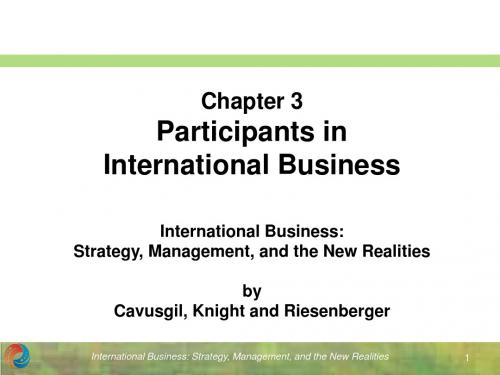
• •
•
Evolution of a Born Global Exporter and Challenges It Overcomes
Some will exceed $100 million Size Manage Niche transition limits issues early
Small Create domestic international sales only position Product or Begin exporting process early (2 years) development
Time
Credibility Finance Export
Finance Innovation… Foreign representation the next Export know-how & skills product Market information
Chapter 3
Participants in International Business
International Business: Strategy, Management, and the New Realities by Cavusgil, Knight and Riesenberger
International Business: Strategy, Management, and the New Realities 11
Foreign Market Entry Strategies of Focal Firms
商务谈判(双语)chapter1

In negotiation people should know the following:5W1H :
1、掌握商务谈判概念 、 2、理解并掌握谈判的原则 、 3、理解谈判的特点,并掌握国际商务谈 、理解谈判的特点, 判的特点 4、初步了解国际商务谈判的主要内容 、
请阅读教材1.1 请阅读教材 Introduction,然后 , 回答下列问题: 回答下列问题:
1、Do you have any experience of negotiating 、
with anyone? 2、Please share your experience with us. 、
1.2 Concepts &Characteristics of &Characteristics Business Negotiation Q1、 What is negotiation? 、 Q2、Why do people negotiate? 、 ? Q3、What are Characteristics of 、 Business Negotiation ?
homework(10%) Attendance record & homework(10%) Notes (10&) Final exam (80%)
Liulinglinglll@ 13407316200
chapter one Introduction and Overview of
作业: 作业:
查阅2005年11月 查阅2005年11月8日,中美 2005 签署的《 签署的《关于纺织品和服装 贸易的谅解备忘录》相关资 贸易的谅解备忘录》 回答: 料,回答: 1)中美双方签署这个协议 的共同利益是什么? 的共同利益是什么? 2)谈谈应该如何理解互利 互惠的原则? 互 Correct Understanding of the Features of IBN 对国际商务谈判的特点的正确理解 1.5 The Main Content of Negotiation on International Business
国际商法知(1)

1.International business is the economic system of exchanging goods, services and intellectual property, conducted between individuals and businesses in multiple countries.2. International business law is the body of rules and norms that regulates business activities carried outside the legal boundaries of states. In particular, it regulates the business transactions of private persons internationally, and the relationship of international commercial organizations.3.International treaties and conventions difference:treaties are binding agreements between two or more states,and conventions are legally binding agreements between states sponsored by international organizations.4.Source of international business law: A.Nation law B.International treaties and conventionsC.International model lawD.International trade customs and usages5.The most important international conventions: The United nations Convention on Contract for the International Sales of Goods(CISG,联合国国际货物销售合同公约)Convention for the Unification of Certain Rules of Law Relating to Bills of Lading (the Hague rules,海牙规则)The Paris Convention for the Protection of Industrial Property (Paris Convention,巴黎公约)Understanding on the Rules and Procedures Governing the Settlement of Disputes (DSU,争端解决规则与程序谅解)6.International model law (国际示范法)means rules and norms worked out and passed by some international organizations for the free choice by nations.7.International trade customs and usage(国际商事惯例) mean the general rules and practices in international trade activities that have become generally adopted through unvarying habit and common use.Influence: not law, but plays an important role.anization Affiliated with UN隶属联合国的组织•The United Nations Economic and Social Council 联合国经社理事会•The United Nations Commission on International Trade Law (UNCITRAL) 联合国国际贸易法委员(promote:international trade through harmonization of trade law among nations.)•International Monetary Fund (IMF)国际货币基金组织IMF Objectives: to promote international monetary cooperation, to facilitate the expansion and balanced growth of international trade and to promote stability in foreign exchange.•The International Bank for Reconstruction and Development 国际复兴开发银行(世界银行)•International Development Association 国际发展协会•International Finance Corporation 国际金融公司9.GATT(关贸总协定与世界贸易组织)--General Agreement on Tariffs and Trade. Purpose:to commit member countries to the principles of nondiscrimination and reciprocity.WTO—World Trade Organization.The Organization for European Economic Cooperation欧洲经济合作组织international Chamber of Commerce 国际商会10.T he Romano-Germanic Civil Law Family罗马日尔曼民法法系: France, Germany, and Switzerland et11.T he Anglo-American Law Family英美法系: England, America, Indiaetc.(Islamic Law Family伊斯兰法系: Islamic countries).12.T he Differences between the two main legal family•1) The basic source of civil law is codes, the basic source of common law is case law.•2) For the status of law, civil law is independent of government, but common law is superior to government.•3) To the base of legal rules, civil law is based on general principles, while common law is based on specific circumstances.•4) Civil law is most influenced by legislators, while common law is most influenced by judges.•5) For the application of law, in civil-law countries deductive means is widely applied, while in common-law countries, inductive means is applied.•6) For the use of case law as precedents, in civil-law countries it’s respected, but in common-law countries it’s required.1.Specialization(专业化)means that each nation should specialize to itsresource endowment by applying the law of comparative advantages.It enables nations to emphasize the activities at which they are most efficient and at the same time gain certain advantages through trade.parative Advantage(相对优势) countries will specialize in producing several products and services in which they have lower opportunity costs than their trading partners .3.Absolute Advantage(绝对优势)countries will specialize in producing several products and services in which they have lower opportunity costs than their trading partners .4.Opportunity Cost(机会成本)means the value of the benefit that is given up to produce one economic good as opposed to another5.Exporting is divided into:direct and indirect.ernment Control Over Trade: a) Tariffs. b) Nontariff Barriers to Trade. c) Export Testrictions.7.tariffs(关税) are taxes imposed on imports or exports when crossing thecustoms either by value or per unit of quantity.a) ad valorem duty 从价税b)specific duty从量税8.Nontariff Barriers to Trade(非关税壁垒) are all barriers to import and exportother thantariffs. significance: to protect national economy, social and politicalinterest.9.I ntellectual property rights(知识产权): are a grant from a government to anindividual or firm of the exclusive legal right to use a copyright, patent ortrademark for a specified time.10.Copyrights(商标) are legal rights to an artistic or written work11.Patents(专利)are governmental grants to inventors assuring them of theexclusive legal right to produce and sell their inventions for a period of years12.International Licensing Agreement s(国际许可协议): are contracts by whichthe holder of intellectual property right will grant certain rights in that propertyto a foreign firm under specified conditions and for a specified time.13.Technology Transfer(技术转让): the exchange of technology andknow-howthrough arrangements such as international licensing contracts.14.International Franchising(国际特许): is form of licensing that is gaining inpopularity worldwide. The most common form of franchising is known as abusiness operations franchise.1.Applicability of the CISG(适用范围):a)for commercial sales of goods,not forconsumer sales. b)between parties whose places of business are in differentcountries.c)the places of business are located in countries that have ratified theconvention.2.Applicability of the CISG Issues not covered(没有涉及的问题): a)the legalityof the contract. b)the competency of the parties. c)the rights of third parties.3.Sales and issue excluded(排除适用的销售):a)consumer goods sold forpersonal, family or household use; b)goods bought at auction; c)stocks,securities, negotiable instruments, or money; d)ships, vessels, or aircraft;e)electricity; f)assembly contracts; g)contracts that are in preponderant part forthe supply of labor or other services; h)liability of the seller for death orpersonal injury caused by the goods; i)parties agree to exclude the Conventionor they choose other law.4.General Principles of CISG(一般原则): a party has the duty to communicateinformation needed by the other party; parties have the obligation to mitigatedamages resulting from a breach5.R ules of Private International law(国际私法原则)Used only when CISG itselfdoes not directly settle a matter, or when the matter cannot be resolved bytheapplication of a general principle derived from the Convention itself.Purpose:to avoid the possibility that courts will adopt interpretive aids on an ad hocbasis.6.Negotiations(谈判): a) the negotiations leading up to the contract b)the practices which the parties have established between themselves. c) theparties’ conduct after they agree to the contract. Purpose: to do away with thetechnical rules that domestic courts use to interpret contract.7.T he parol evidence rule(口头证据规则)8.Force Majeure(不可抗力)9.Practices and Usages(惯例):•Art.8(3)and 9(1): any practice they haveestablished betweenthemselves. •Art.9(1): any usage which the parties agreedto. •Art.9(2): a usage which the parties knew or ought to have known andwhich is widely known to and regularly observed.10.Principles of International Commercial Contracts(UNIDROIT PICC,国际商事合同通则) is a non-legislative means of unification or harmonization of law inthe area of international commerce. (The most important model laws ofinternational commerce.)11.General principles of the UNIDROIT PICC(一般原则):Freedom of Contract;openness to Usages; Favor Contractus; Observance of Good Faith and FairDealing in International Trade.12.The Purposes of the PICC: A model for national and international legislators;A means of interpreting and supplementing existing international instruments; Aguide for drafting contracts; The PICC as rules governing the contract.13.T he Importance of CISG: The CISG was unanimously adopted in 1980 by adiplomaticconference held in Vienna, it represents a landmark in the process ofinternational unification of law. The importance is further demonstrated by thefact that the number of decisions rendered by both state courts and arbitraltribunals in its applications is rapidly increasing.14.T he Shortcomings of CISG: a) CISG is less comprehensive in contents; b)some provisions in UNIDROIT are more reasonable and suitable; c) thetrade-encouraging principle is better embodied in UNIDROIT.15.Incoterms(国际贸易术语) is a set of trade term definition published by theInternational Chamber of Commerce (ICC), which provides rules to determinethe obligations of both seller and buyer. (First published in 1936,the newestrevision is in 2000.)16.EXW: Ex Works(工厂交货) FCA:free carrier(货交承运人) FAS: free alongsideship(装运港船边交货) FOB: free on board (装运港船上交货) CFR: cost andfreight(成本加运费) CIF: cost, insurance and freight(成本、运费加保险费) CPT:carriage paid to(运费付至) CIP: carriage and insurance paid to(运费、保险费付至) DAF: delivered at frontier(边境交货) DES: delivered ex ship(目的港船上交货) DEQ: delivered ex quay(目的港码头交货) DDU: delivered duty unpaid(未完税交货) DDP: delivered duty paid(完税后交货)1.Contract(合约): A) English Law: A promise or a set of promises, for breach ofwhich the law gives a remedy, or the performance of which the law in some wayrecognizes as a duty.•B) American Law: A promise or a set of promises that the law will enforce or atleast recognize in some way.•C) French Civil Code1101: Contract is a mutual assent withwhich one person ormore is obligated to give a thing, to do or not to do a thing to one person ormore persons.•D) China Contract Law: A contract is an agreement establishing, modifying andterminating the civil rights and obligations between natural persons, legalpersons or other organizations.2.Form of Contract(合同的形式):means whether a contract is made inwriting or orally•A) English Law: early period required that contract be in writing. 1906 revisedSales of Goods Act repealed the writing requirement.•B) American Law: UCC requires that contracts for sale of goods for $500 or thatmore must in writing. However, at present many exceptions to this rule makemost oral sales of contracts enforceable.•C) CISG: contracts of sale need not be concluded in or evidenced by writing andis not subject to any other requirements as to form. It may be proved by anymeans, including witnesses.•D) UNIDROID PICC: almost the same with CISG•E) China Foreign Economic Contract Law:a contract will be established whenthe parties reach agreement on the articles in writing and sign their names.3.Validity(有效性):under the common law, a valid contract is anagreement that contains all of the essentials of a contract.4.Contract contains four elements(合同四要素): a) it is an agreementbetween the parties entered into by their mutual assent. b) the contract mustbe supported by legally sufficient consideration. c) the parties must have legalcapacity. d) the contract must not be for illegal purposes or to carry on anactivity that is illegal or contrary to public policy.5.Offer(要约) :An offer is a proposal by one person to another indicating anintention to enter into a contract under specified terms.6.Requirements of offer(要约的要求):a) an offer must be addressed toone or more specific persons.; b) an offer must be sufficiently definite andindicates the intention of the offeror to be bound; c) an offer becomes validwhen it arrives at the offeree.7.An offer(inCISG)can’t be revoked(撤销) (a) if it indicates that it isirrevocable or (b)if it was reasonable for the offeree to rely on the offer as beingirrevocable and the offeree has acted in reliance on the offer.pse of Offer(要约的失效):a) On the death either of the offeror or theofferee before acceptance.; b) By non-acceptance within the time prescribed foracceptance by the offeror; c) when no time for acceptance is prescribed, bynon-acceptance within a reasonable time.9.Revocation of offer(要约的撤销):means that the offeror notifies theofferee before acceptance of the invalidity of the offer so as to be free from it.10.Acceptance(接受):The acceptance is the offeree’s manifestation of theintention to be bound to the terms of the offer.11.Requirements of Acceptance: a) must be made by the offeree; b) mustbe made within the period of validity; c) must match the terms of the offerexactly and unequivocally.12.The mirror image rule(镜像原则):The rule requires that an acceptancebe unconditional and that it not attempt to change any of the terms proposed inthe offer.13.Consideration(对价) is some benefit received by a party who gives apromise or performs an act, or some detriment suffered by a party who receivesa promise. Under common law, it is one of the three elements of contractformation.14.General Rules on Consideration(对价的一般原则): a) is required for allsimple contract( not under seal); b) must have a value recognized by law butneed not be equal to the promise; c) must be present or future and cannot bepast; d) must be possible to perform; e) must be legal; f) must move from thepromisee; h) must not be too vague; I) performance of an existing contractualduty is not valuable consideration.15.Exceptions(例外) to the Consideration Requirement: a) contract underseal (密封的合同); b) promissory estoppel (禁止反言)16.Misrepresentation(错误陈述):the basic idea of misrepresentation is thatone party makes false statement and the other party thus enters into a contractby justifiably relied on it.17.Elements of Misrepresentation(错误陈述的要素): misrepresentation ofa material fact and the harmed party justifiably relied on the statement.18. A material fact is one that would contribute to a reasonable person’sdecision to enter the contract.19.Three types of misrepresentation(三种类型):fraudulentmisrepresentation(欺诈性)--the representor made a falsestatement(Remedies:damages); innocent misrepresentation(无意的)--therepresentor did not know the statement was false and was not recklesslyindifferent about its truthfulness(Remedy:avoidance of the contract); negligentmisrepresentation(过失的)--the representor makes a false statement innocentlybut carelessly(Remedy:damages);20.Mistakes(误解):(under common law) mean a misunderstanding betweenparties about a fact to the contract.(Under common law,there three types ofmistakes:commonmistake;mutualmistake;unilateral mistake.)21.Mistakes: (under Civil Law) :“Error relating to the nature ofcontractedobject amounts to the cause for an invalid contract.”22.Mistakes:(under The UNIDROID PICC)as”an erroneous assumptionrelating to facts or to law existing when the contract was concluded.”23.Mistakes:(under China Contract Law)A party shall have the right torequest the people’s court or an arbitration institution to modify or revoke thefollowing contract:(1)those concluded as a result of seriousmisunderstanding;(2)those that are obviously unfair at the time whenconcluding the contract.24.Serious misunderstanding:(1)misunderstanding to the nature ofcontract;(2)misunderstanding to the other party;(3)misunderstanding to thequality of the contracted object;(4)misunderstanding to the assortment of thecontracted object;(5)misunderstanding to the price and expenses.25.Fraud(欺诈):under Common law,the legal term is scienter.T o prove fraud,one must prove the other party: (1)Knowingly made with a)Know exactly thathis states was false;b)Know that he did not have a basis for thestatement;c)Without being confident that his statement was true. (2)Intent todeceive: can be inferred from the fact that the defendant knowingly made amisstatement of fact to a person who was likely to rely on it. Remedies:rescind the contract or affirming the contract and suing in tort for damagesresulting from the fraud.26.Duress(胁迫):(under common law)is wrongful coercion that induces aperson to enter or modify a contract.27.Elements to be established:(1) the contract was induced by an improperthreat;(2) the victim had no reasonable alternative but to enter the contract.28.Undue Influence(不正当影响):a party uses a position of influence topersuade the other party to enter a contract that provides the stronger partywith a direct or indirect benefit.29.Purpose of Undue Influence: to protect the old, the timid, and thephysically or mentally weak from those who gain their confidence and attemptto take advantage of them.30.Types of Undue Influence:1) the defendant occupied a legally recognizedposition of authority of influence(special relationships: parent and child; trusteeand beneficiary; doctor and patient; solicitor and client; guardian and ward;religious adviser and devotee);2) the defendant did not occupy a legallyrecognized.31.Unconscionable Conduct(不公平行为):A contract may be avoidable onthe grounds of unconscionable conduct.。
自考商务英语1-3单元专业术语
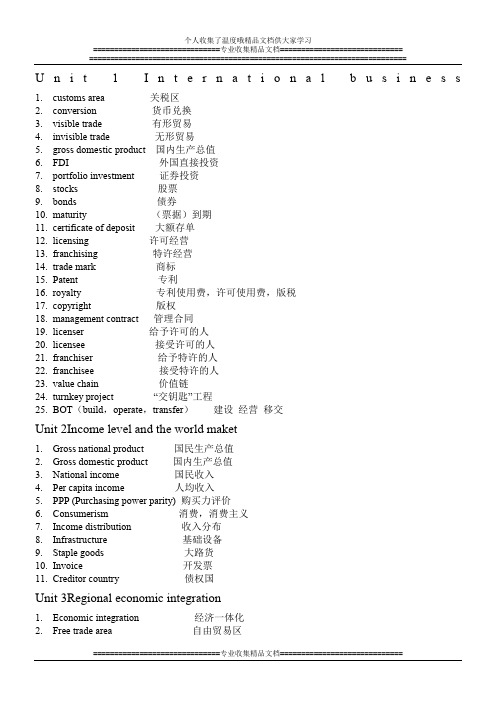
U n i t1I n t e r n a t i o n a l b u s i n e s s1.customs area 关税区2.conversion 货币兑换3.visible trade 有形贸易4.invisible trade 无形贸易5.gross domestic product 国内生产总值6.FDI 外国直接投资7.portfolio investment 证券投资8.stocks 股票9.bonds 债券10.maturity (票据)到期11.certificate of deposit 大额存单12.licensing 许可经营13.franchising 特许经营14.trade mark 商标15.Patent 专利16.royalty 专利使用费,许可使用费,版税17.copyright 版权18.management contract 管理合同19.licenser 给予许可的人20.licensee 接受许可的人21.franchiser 给予特许的人22.franchisee 接受特许的人23.value chain 价值链24.turnkey project “交钥匙”工程25.BOT(build,operate,transfer)建设经营移交Unit 2Income level and the world maket1.Gross national product 国民生产总值2.Gross domestic product 国内生产总值3.National income 国民收入4.Per capita income 人均收入5.PPP (Purchasing power parity) 购买力评价6.Consumerism 消费,消费主义7.Income distribution 收入分布8.Infrastructure 基础设备9.Staple goods 大路货10.Invoice 开发票11.Creditor country 债权国Unit 3Regional economic integration1.Economic integration 经济一体化2.Free trade area 自由贸易区3.Customs union 关税同盟4.Tariff rates 关税税率5.Settlement 结算6.North American Free Trade Agreement (NAFTA) 北美自由贸易协定mon market 共同市场8.Banknotes circulation 货币流通9.Cartel 卡特尔 pacific Economic Cooperation (APEC) 亚太经济合作组织anization of Petroleum Exporting Countries (OPEC) 石油输出国组织12.European Commission 欧盟委员会13.Council of ministers 部长理事会14.Dual-Ministerial Meeting 双部长会议Unit 4 Economic GlobalizationShare holders 股东,所有人Economic globalization 经济全球化Board of directors 董事会Inputs 投入Economic environment 经济环境Parent company 母公司,总公司,上级公司Affiliate 分支机构,会员Day-to-day running 日常管理Multinational Corporation (enterprise) 跨国公司/企业Home country 母国Host country 东道国Unit 5 International Trade (1)Services 劳务Primary commodities 初级产品Specialization 专业化Absolute advantage 绝对利益Comparative advantage 比较优势Capital, land and labor 资本,土地和劳动力(生产三要素)Unit 6 International Trade (2)Tariff 关税Quota 配额Customs area 关税区Customs union 关税联盟Import duties 进口关税Export duties 出口关税Ad valorem duty 从价税Specific duty 从量税Compound duties 复合税,混合关税Drawback 退税Most-favored-nation (MFN) 最惠国Tariff schedule 税率表,税则Non-tariff barrier 非关税壁垒Visible trade 有形贸易Invisible trade 无形贸易Unit 7Deal 交易trade terms 贸易术语trading practices 贸易惯例negotiable (票据,股票)可转让的,可流通的EDI 电子数据交换,customs clearance 结关dispatch 发送International Chamber of Commerce(ICC)国际商会roll on-roll off 滚装滚卸的Incoterms 国际贸易术语解释通则nagotiable transport document 可转让装运单据EXW 工厂交货,FCA 货交承运人,FAS 装运港船边交货,FOB 装运港船上交货CFR 成本加运费CIF 成本,保险费和运费CPT 运费付至,CIP 运费、保险费付至,DAF 边境交货,DES 目的港船上交货,DEQ 目的港码头交货,DDU 未完税交货,DDP 完税交货Unit8Inquiry 询盘、报价,Quotation 报价,validity period 有效期,offer 发盘,counter offer 还盘,offeree 收盘人,sales(purchase)contract 销售(购货)合同,sales (purchase)confirmation 销售(购货)确认书,consignment 寄售,contracting parties 缔约方,force majeure 不可抗力,arbitration 仲裁,business line 业务(经营)范围, contract proper 合同正文,article number 货号Unit 9Counter trade 对销贸易, Hyperinflation 极度通货膨胀, Reichsbank 德国国家银行,cross-border contract 进出口合同, protectionism 贸易保护主义,financial market 金融市场,Clearing system 清算系统,net positions 实际头寸, compensation trade 补偿贸易,trade credit accounts 贸易信贷往来帐户, barter 易货交易,counter purchase 互购贸易,Buyback 回购交易,Vertical 垂直的、生产销售全过程, centrally planned economies 中央计划经济国家, competitive devaluation 竞争性贬值, Volkswagen 大众汽车公司,Xerox Corporation 施乐公司,processing trade 加工贸易,consignment 寄售,leasing trade 租赁贸易,auction 拍卖,agency 代理Unit 10debtor 债务人debit 借方,将……记入借方financial standing 财务状况credit worthiness 资信可靠状况periodic payments 分阶段付款cash in advance 预付现金open accout 记账交易draft(bill of exchange)汇票drawer 出票人drawee 受票人payee 受款人usance draft (honor draft, term draft) 远期汇票documentary draft 跟单汇票clean draft 光票documentary collection 跟单托收documents against payment(D/P)付款交单documents against acceptance(D/A)承兑交单Unit11applicant 开证申请人opening bank 开证银行beneficiary 受益人correspondent bank 往来行,关系行advising bank 通知行amendment 修改confirming bank 保兑行reimburse 付款unit price 单价partial shipment 分批装运transshipment 转船the uniform customs and parctice of documentary credits 跟单信用证统一惯例,或简称“统一惯例”in favor of 以……为受益人the carrying vessel 运载船只,载货船只Unit 12clean credit 光票信用证non-trade settlement 非贸易结算revocable credit 可撤销信用证irrevocable credit 不可撤销信用证maturity 到期,期满confirmed credit 保兑信用证leading bank 主要银行sight credit 即期信用证capital turnover 资金周转face value 面值transferable credit 可转让信用证non-transferable credit 不可转让信用证non-draft credit 无汇票信用证discount 贴现deferred payment 推迟付款revolving credit 循环信用证insolvent 无支付能力的Unit 13Documents 单据Take delivery of提(货)Commission佣金Discount折扣Shipping marks运输标记, 唛头Bill of lading 提单Carrier 承运人Shipper货主托运人Consignor托运人Carriage 运输Consignee收货人Notify party 被通知人Payable 应支付的Airway bill 空运提单Insurance policy 保险单Cargo receipt 货物收据Commercial invoice 商业发票Legal holder 合法持有人Insurance certificate 保险证书Customs invoice海关发票Consular invoice领事发票Consular visa 领事签证Shipping advice装船通知Certificate of health 健康证书Certificate of disinfection 消毒证书Certificate of origin 货物原产地证明书Veterinary certificate 兽医证书Unit 14Documentation 单据的制作或使用Finished products 制成品Deregulation 解除控制,撤消管制规定Productivity 生产率Cost economies 节约成本Intermediate products 中间产品Natural product province 产品自然领域Inventory 存货库存Logistics 物流Just-in-time inventory system 零库存Common carrier 公共承运人Contract carrier 契约承运人Private carrier 自有承运人Unit 15Insured 被保险人Insurer 承保人Claim 索赔Client 客户Margin 保证金Draw 提取Jeopardy 风险,危险Literature 文献,说明书(此处指商品目录,价目表)Underwriter 保险公司Known premium 已知的保险费Pool 基金,共用款Cargo insurance 货物保险Marine insurance 海运保险Unit 16Port of origin 货物原产地港口V oidable 可使无效的,可以取消的Indemnity 损失赔偿Ruin 毁灭Insurable interest 可保险权益Terms of sale 价格条件All risks 全险Principle of utmost good faith 最大诚信原则Subrogation 代位,取代Contribution 损失费用分摊原则Proximate cause of the loss 近因原则Forwarding charges 交货费用Free from particular average 平安险With particular average 水渍险Unit 17Exchange rate 汇率Gold standard 金本位制Peg 钉住,挂钩Par value 平价Reserve currency 储备货币Clean float 清洁浮动,自由浮动Dirty float 肮脏浮动,管理浮动Discount 贴现Idle funds 游资Indirect quote 间接标价Direct quote 直接标价Buying rate 买入价Selling rate 卖出价Medial rate 中间价Unit 18Financial resources 资金Finance 提供资金Earnings 收益,盈利Private sector 私营经济Balance of payments 国际收支Equity investment 股权投资Grace period 优惠期Capital infrastructure (资本密集型)基础设施World Bank Group 世界银行集团International Bank for Reconstruction and Development(IBRD) 国际复兴开发银行International Development Association(IDA) 国际开发协会International Finance Corporation(IFC) 国际金融公司Multilateral Investment Guarantee Agency(MIGA) 多边投资担保机构Unit 19returns 收益,回报customer mobility 客户流动inventory 存货tax holiday 免税期green-field strategy 绿地战略acquisition 并购joint venture 合资企业Unit 20investor 投资者securities 有价债券finance 融资equities 权益,普通股broker 经纪人jobber 股票买卖经纪人hedge 套期保值shortfall 亏空,不足,财政赤字stock exchange 证券交易所long-term capital 长期资本secondary capital market 二级资本市场primary capital raising 初级资本筹集market floor 交易所market maker 市场交易人listed market 挂牌市场income tax 所得税gilt-edged stocks options 金边债券期权cost-effective 节约成本public sector borrowing requirement 公共部门借贷需求books 帐本value added tax (V AT) 增值税institutional investors 机构投资商Unit 21most-favored nation clause 最惠国条款generalized system of preferences 普惠制non-discriminate 非歧视contracting party 缔约国tariff quota 关税配额trade-related 与贸易有关的standard of living 生活水平full employment 充分就业tariff concession 关税减免Uruguay Round 乌拉圭回合Counter-veiling measures 反补贴措施Anti-dumping 反倾销National treatment 国民待遇Unit 22The united nations conference on trade and development1.Escape clauses 免责条款2.United nations general assembly 联合国大会3.Invisibles 无形贸易4.Non-discrimination principle 非歧视原则5.Terms of trade 贸易条款6.New international economic order 新国际经济秩序7.Differential treatment 差别待遇8.Preferential customs tariffs 特惠税9.Transfer of technology 技术转让10.。
自考国际商务英语_句子翻译
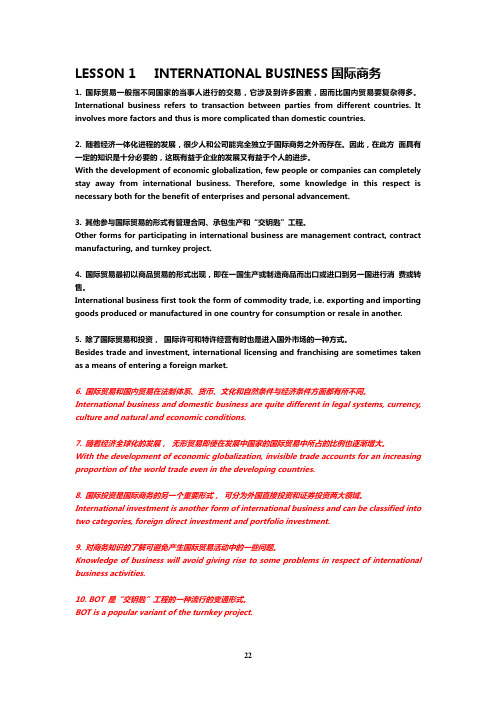
LESSON 1 INTERNATIONAL BUSINESS国际商务1. 国际贸易一般指不同国家的当事人进行的交易,它涉及到许多因素,因而比国内贸易要复杂得多。
International business refers to transaction between parties from different countries. It involves more factors and thus is more complicated than domestic countries.2. 随着经济一体化进程的发展,很少人和公司能完全独立于国际商务之外而存在。
因此,在此方面具有一定的知识是十分必要的,这既有益于企业的发展又有益于个人的进步。
With the development of economic globalization, few people or companies can completely stay away from international business. Therefore, some knowledge in this respect is necessary both for the benefit of enterprises and personal advancement.3. 其他参与国际贸易的形式有管理合同、承包生产和“交钥匙”工程。
Other forms for participating in international business are management contract, contract manufacturing, and turnkey project.4. 国际贸易最初以商品贸易的形式出现,即在一国生产或制造商品而出口或进口到另一国进行消费或转售。
International business first took the form of commodity trade, i.e. exporting and importing goods produced or manufactured in one country for consumption or resale in another.5. 除了国际贸易和投资,国际许可和特许经营有时也是进入国外市场的一种方式。
2014级商务导论lesson 1 International Business

(1) Preferential duties (优惠关税) Duty applied to importing goods according to its geographical source; a country that is given preferential treatment pays a lower tariff.
Acombination of duty placed on imported items, the amount of which is based on the above two duties.
E.g. 10% of the value + $1 per battery
If there is a shipment of 100 batteries valued at $2000
6. Forms of International Operation Agents Licensing/Franchising Outsourcing Branch Offices Direct investment
Global Business
7. Special Issues
Social & Cultural Differences Foreign Exchange Trade Barriers Tariffs Non-Tariff Barriers
① Circulation of goods, capital, services, employees & technology ② Importing & exporting ③ Cross-border transaction in IPR by licensing & franchising ④ Financing
国际经贸英语合同写作上册课后答案
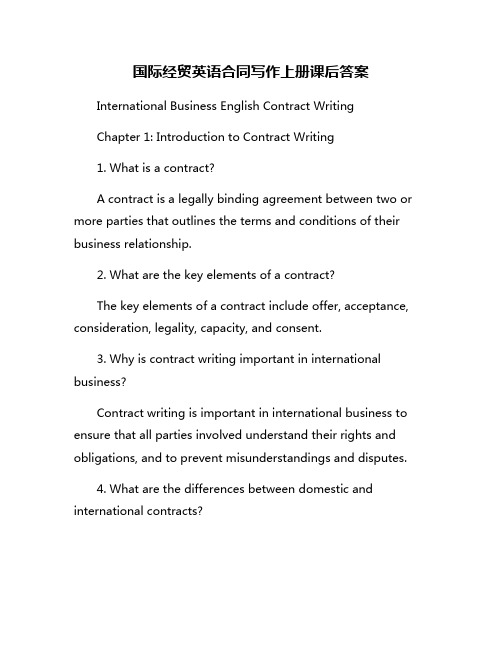
国际经贸英语合同写作上册课后答案International Business English Contract WritingChapter 1: Introduction to Contract Writing1. What is a contract?A contract is a legally binding agreement between two or more parties that outlines the terms and conditions of their business relationship.2. What are the key elements of a contract?The key elements of a contract include offer, acceptance, consideration, legality, capacity, and consent.3. Why is contract writing important in international business?Contract writing is important in international business to ensure that all parties involved understand their rights and obligations, and to prevent misunderstandings and disputes.4. What are the differences between domestic and international contracts?International contracts often involve parties from different countries, multiple legal systems, and various currencies, making them more complex than domestic contracts.Chapter 2: Contract Types and Formats1. What are the different types of contracts?The different types of contracts include sales contracts, distribution agreements, licensing agreements, and joint venture agreements.2. What formats can contracts be written in?Contracts can be written in various formats, such as standard forms, letters of intent, memoranda of understanding, and formal written agreements.3. How can cultural differences impact contract writing?Cultural differences can impact contract writing by affecting language interpretation, negotiation styles, and business practices. It is important to consider cultural differences when drafting international contracts.Chapter 3: Contract Clauses and Terms1. What are boilerplate clauses?Boilerplate clauses are standard contract terms that are often included in contracts to address common issues, such as termination, indemnification, and governing law.2. What are the key terms to include in a contract?Key terms to include in a contract include payment terms, delivery terms, warranties, dispute resolution mechanisms, and confidentiality provisions.3. How can language be used to clarify contract terms?Language can be used to clarify contract terms by defining key terms, avoiding ambiguous language, and using clear and concise language.Chapter 4: Contract Negotiation and Drafting1. What are the key steps in contract negotiation?The key steps in contract negotiation include identifying the parties' interests, discussing and negotiating the terms of the contract, and reaching a mutual agreement.2. How can contracts be drafted effectively?Contracts can be drafted effectively by clearly outlining the parties' rights and obligations, using specific language, and referencing relevant laws and regulations.3. What are common pitfalls to avoid in contract drafting?Common pitfalls to avoid in contract drafting include using vague language, omitting key terms, and failing to capture the parties' intentions accurately.In conclusion, contract writing is a vital skill for professionals in international business. By understanding the key elements of contracts, the different types and formats of contracts, the importance of contract clauses and terms, and the best practices for contract negotiation and drafting, professionals can successfully navigate the complexities of international business contracts and build strong business relationships.。
希尔 《国际商务》第11版 英文PPT Chapter 1Chapter1

Chapter 1
Globalization
Copyright © 2017 McGraw-Hill Education. All rights reserved. No reproduction or distribution without the prior written consent of McGraw-Hill Education.
What Is Globalization?
➢Globalization - the shift toward a more integrated and interdependent world economy
➢The world is moving away from self-contained national economies toward an interdependent, integrated global economic system
1-7
Why Do We Need Global Institutions?
➢Global institutions
➢ help manage, regulate, and police the global marketplace ➢ promote the establishment of multinational treaties to govern
Copyright © 2017 McGraw-Hill Education. All rights reserved. No reproduction or distribution without the prior written consent of McGraw-Hill Education.
国际商务International Business (Charles W.L. Hill 第七版)

Summary
❖There are no “right” decisions when deciding which markets to enter, and the timing and scale of entry, just decisions that are associated with different levels of risk and reward
14-7
Timing Of Entry
❖First mover advantages are the advantages associated with entering a market early
First mover advantages include: ❖the ability to pre-empt rivals and capture demand by establishing a strong brand name ❖the ability to build up sales volume in that country and ride down the experience curve ahead of rivals and gain a cost advantage over later entrants ❖the ability to create switching costs that tie customers into products or services making it difficult for later entrants to win business
Firms expanding internationally must decide: ❖which markets to enter ❖when to enter them and on what scale ❖which entry mode to use
第一章国际商务导论教学教材
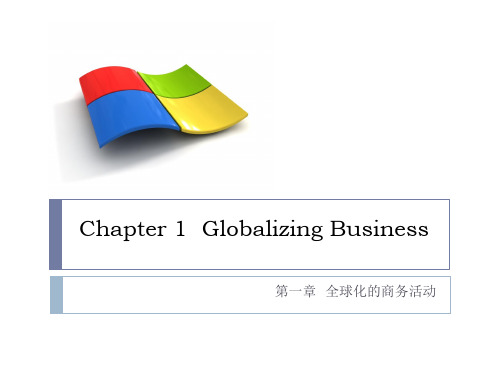
traditional International business books and; 2. domestic business activities.
3
International Business and Global Business
Many previously national (domestic) markets are now globalized.
9
Second Core Perspective: A Resource-Based View
The resource-based view focuses on a firm’s internal resources and capabilities.
Foreign firms have to overcome a liability of foreignness, which is the inherent disadvantage that foreign firms experience in host countries because of their nonnative status.
Chapter 1 Globalizing Business
第一章 全球化的商务活动
International Business and Global Business
International Business (IB) is defined: 1. a business (firm) that engages in international (cross-
国际商务函电——完整unit 1 business letter writing
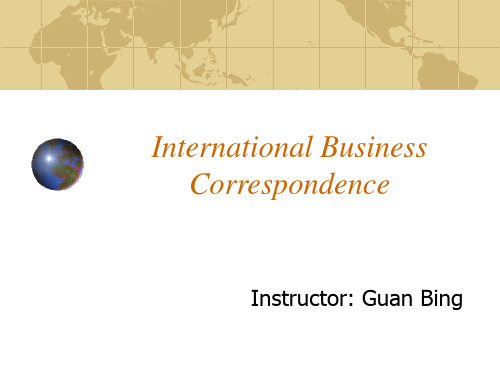
abbreviations and abbreviated phrases 3. There is a close relation between BEC and
international trade
Examples:
in the market for, offer, quotation, order, counteroffer, letter of credit, CIF, FOB, ASAP, P.P.,YL11/11RVD
We will send you the brochure next month.
B. Focus on the positive approach.
Compare:
(positive) We feel sure that you will be entirely satisfied.
(negative) We do not believe you will have cause for dissatisfaction.
(1) Avoid using wordy expressions. For example: Wordy: We wish to acknowledge receipt of your letter… Concise: We appreciate your letter… Wordy: We have begun to export our electronic toys to countries abroad. Concise: We have begun to export our electronic toys.
商务英语Unit 1 Studying International Business
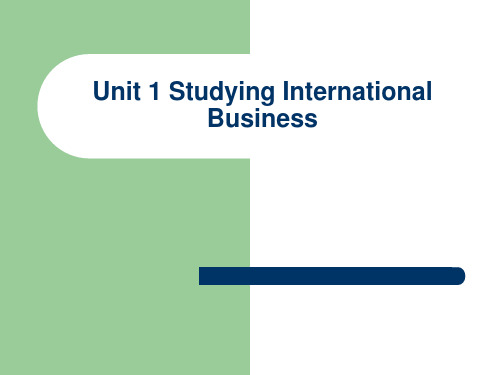
They are investments made for the purpose of actively controlling property, assets, or companies located in host country. (国际直接投资的目的是为了控制一个公司的 资产,从而直接控制其经营活动。) (2)Portfolio investment(证券投资,间接投资) They are purchases of foreign financial assets (stocks, bonds, and certificates of deposit) for a purpose other than control and in anticipation of returns. (国际间接投资的目的是购买金融资产,通过 金融资产的价格变化来盈利。)
(2)Trade in services is called invisible trade, which are intangible products such as travel, banking and insurance. (无形贸易又称为服务ent(国际投资) 、 (国际投资)
五、近年来国际商务发展的原因 (Reasons for recent International business growth) )
1、Rapid increase in and expansion of technology(迅速增加和发展的技术) Knowledge of products and services is available more widely and quickly because of tremendous strides in communications and transportation technology. (特别是通信技术和运输技术的发展使得产品 和技术的贸易越来越迅速、广泛。)
International Business
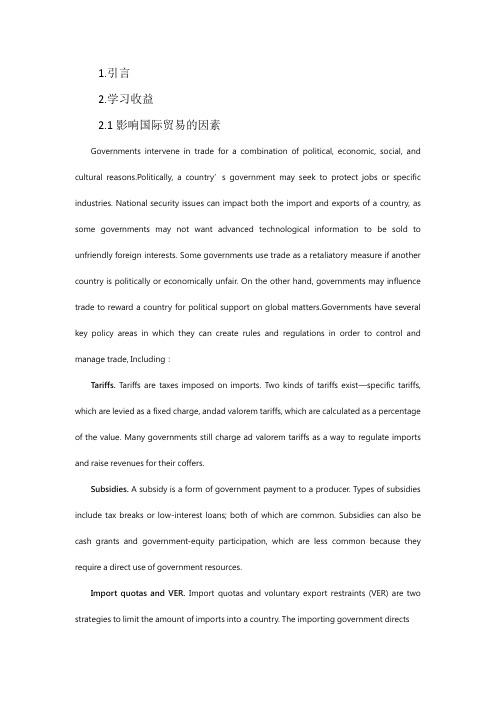
1.引言2.学习收益2.1影响国际贸易的因素Governments intervene in trade for a combination of political, economic, social, and cultural reasons.Politically, a country’s government may seek to protect jobs or specific industries. National security issues can impact both the import and exports of a country, as some governments may not want advanced technological information to be sold to unfriendly foreign interests. Some governments use trade as a retaliatory measure if another country is politically or economically unfair. On the other hand, governments may influence trade to reward a country for political support on global ernments have several key policy areas in which they can create rules and regulations in order to control and manage trade, Including:Tariffs.Tariffs are taxes imposed on imports. Two kinds of tariffs exist—specific tariffs, which are levied as a fixed charge, andad valorem tariffs, which are calculated as a percentage of the value. Many governments still charge ad valorem tariffs as a way to regulate imports and raise revenues for their coffers.Subsidies. A subsidy is a form of government payment to a producer. Types of subsidies include tax breaks or low-interest loans; both of which are common. Subsidies can also be cash grants and government-equity participation, which are less common because they require a direct use of government resources.Import quotas and VER.Import quotas and voluntary export restraints (VER) are two strategies to limit the amount of imports into a country. The importing government directsCurrency controls. Governments may limit the convertibility of one currency (usually its own) into others, usually in an effort to limit imports. Additionally, some governments will manage the exchange rate at a high level to create an import disincentive.Local content requirements.Many countries continue to require that a certain percentage of a product or an item be manufactured or “assembled” locally. Some countries specify that a local firm must be used as the domestic partner to conduct business.Antidumping rules. Dumping occurs when a company sells product below market price often in order to win market share and weaken a competitor.Export ernments provide financing to domestic companies to promote exports.Free-trade zone. Many countries designate certain geographic areas as free-trade zones. These areas enjoy reduced tariffs, taxes, customs, procedures, or restrictions in an effort to promote trade with other countries.Administrative policies.These are the bureaucratic policies and procedures governments may use to deter imports by making entry or operations more difficult and time consuming.2.1.1多角度看待问题Through the study of this chapter, let me experience the charm of multiculturalism, as well as anything there is diversity. Only with a comprehensive view of the problem, with reflective thinking to solve the problem. As Marxism put it: to use dialectical thinking, in order to make progress in school and career and development. For example: I hope to be admitted to a foreign university after two years, I need to consider a number of factors, first, whethermy parents support my idea; second, whether my learning ability can meet the requirements of the entrance examination; finally, how should I make a plan, start studying for the test.After the above preliminary thinking, I began to read and organize Liaozhai. The software I used was imind (a mind mapping software). At first, I made the time line and the place line in the same map. However, with the continuous progress of sorting out, I found that the time and place frame of Liaozhai was very large, so big that my imind file collapsed at the moment of opening, and the map originally used for sorting out thinking was also messy, so I began to make the time line and place line in two maps respectively.This change took place nearly two months after I made the original map. Suddenly, I realized that the confusion of the map was not due to my poor skills of only making the map, but to the fact that many stories across multiple places and time periods made the mind map unable to maintain a clear face (because of the confusion of the lines, like the chronicles and chronicles of historical books, they can only be independent of each other, not completely miscellaneous Mix).2.2发达国家与发展中国家Developed economies, also known as advanced economies, are characterized as postindustrial countries—typically with a high per capita income, competitive industries, transparent legal and regulatory environments, and well-developed commercial infrastructure. Developed countries also tend to have high human development index (HDI) rankings—long life expectancies, high-quality health care, equal access to education, and high incomes. In addition, these countries often have democratically elected governments.In general, the developed world encompasses Canada, the United States, Western Europe,Japan, South Korea, Australia, and New Zealand.The developing world refers to countries that rank lower on the various classifications from . The residents of these economies tend to have lower discretionary income to spend on nonessential goods (i.e., goods beyond food, housing, clothing, and other necessities). Many people, particularly those in developing countries, often find the classifications limiting or judgmental. The intent here is to focus on understanding the information that a global business professional will need to determine whether a country, including a developing country, offers an interesting local market. Some countries may perceive the classification as a slight; others view it as a benefi.All of the emerging-market countries were once considered developing nations.2.2.1看清事物的本质In the past, people defined whether a country belonged to a developed country or a developing country. They were all defined by GDP per capita. However, GDP per capita alone obviously has many shortcomings. The first is that GDP per capita is very unstable and fluctuates very much due to the impact of exchange rates and prices Large, followed by GDP per capita only represents the economic level, but not the overall development level of a country. Therefore, the essential difference between developed and developing countries is clearly the development of productive forces, and productive forces determine production relations. The meaning of productive forces is simply the ability of the entire society to produce, that is, the ability to create wealth.For young people, we have to learn to stand on the whole, see the essence of things. The essence of my study is to cultivate good study habits, study skills to improve comprehensiveability, and to establish noble moral sentiments. Everything is for personal progress and long-term development, so that understanding, we can learn to provide a continuous source of motivation.2.3区域经济一体化Regional economic integration has enabled countries to focus on issues that are relevant to their stage of development as well as encourage trade between neighbors.There are four main types of regional economic integration.1.Free trade area. This is the most basic form of economic cooperation. Member countries remove all barriers to trade between themselves but are free to independently determine trade policies with nonmember nations. An example is the North American Free Trade Agreement (NAFTA).2.Customs union. This type provides for economic cooperation as in a free-trade zone. Barriers to trade are removed between member countries. The primary difference from the free trade area is that members agree to treat trade with nonmember countries in a similar manner. The Gulf Cooperation Council (GCC)[1] is an example.mon market. This type allows for the creation of economically integrated markets between member countries. Trade barriers are removed, as are any restrictions on the movement of labor and capital between member countries. Like customs unions, there is a common trade policy for trade with nonmember nations. The primary advantage to workers is that they no longer need a visa or work permit to work in another member country of a common market. An example is the Common Market for Eastern and Southern Africa (COMESA).4.Economic union. This type is created when countries enter into an economic agreement to remove barriers to trade and adopt common economic policies. An example is the European Union (EU).2.3.1合作共赢谋发展Governments in the regional economic integration in cooperation, which has played a reference to my learning. A person's strength is limited, if can unite the classmate, form the study cooperation group, integrate and optimize the study resources, form the evaluation and competition mechanism, then can study efficiency maximization.This also makes it easy for me to understand that the global human beings should form cooperative relations, in the face of world problems, we are all "community of destiny. "In the process of teaching, group cooperative learning is a teaching mode that teachers often adopt. However, in the actual teaching, group cooperation is often unsatisfactory, which makes cooperative learning meaningless and deviates from the original intention of cooperative learning.2.4进口与出口Importing is the flipside of exporting. Importing refers to buying goods and services from foreign sources and bringing them back into the home country. Importing is also known as global sourcing.In short,The exporter, who is the person or entity sending or transporting the goods out of the countryoThe importer, who is the person or entity buying or transporting goods from another country into the importer’s home country.2.4.1中间人的作用This chapter got me thinking a lot, and I realized that "intermediaries" are everywhere in our lives, such as librarian, real estate agents, banks as regulators, customs, and so on, they often act as a third party to assess the strength of both parties to a transaction and temporarily supervise the assets to ensure that the transaction is more standardized and safe. It can be said that the third party is the referee in trading activities, reduce the risk of activities.2.5什么是好策略you summarize the characteristics of a firm’s bu siness and corporate strategy in terms of five facets—arenas, differentiators, vehicles, staging and pacing, and economic logic.•All five facets are interrelated. When the five elements of strategy are aligned and mutually reinforcing, the firm is generally in a position to perform well.Arenas. The specific geographic markets and the channels and value-chain activities in those markets.Differentiators. How being international differentiates the organization from competitors, makes products or services more attractive to future customers, and strengthens the effectiveness of the differentiators in the chosen arenas.Vehicles. The preference to use organic investment and growth, alliances, or acquisitions as expansion vehicles.Staging and pacing. When you start expanding, how quickly you expand and the sequence of your expansion efforts.Economic logic. How your international strategy contributes to the overall economic logic of your business and corporate strategies.2.5.1策略价值体现In this section, I understand the five factors that affect the success of an enterprise and what is the intention behind the enterprise's transnational expansion strategy. In fact, the aim of these multinational enterprises is to expand the influence and control of their brands, and indirectly enhance the overall strength of the country.With the deepening of economic globalization, the competition between enterprises has gradually shifted from the competition of product performance and service to the competition of corporate culture and brand. In this context, the competition between enterprises has become increasingly fierce, which is both an opportunity and a challenge for enterprises.Based on the past study of this course, I understand that the long-term development of a person should be based on the present, but also to plan for the future. The same is true of learning, as far as possible not partial subject, love each subject and depth of learning, so that their learning is more professional and comprehensive.3.结论。
- 1、下载文档前请自行甄别文档内容的完整性,平台不提供额外的编辑、内容补充、找答案等附加服务。
- 2、"仅部分预览"的文档,不可在线预览部分如存在完整性等问题,可反馈申请退款(可完整预览的文档不适用该条件!)。
- 3、如文档侵犯您的权益,请联系客服反馈,我们会尽快为您处理(人工客服工作时间:9:00-18:30)。
The International Business Does Not Have That Power
Some people might hold an idea that the international business could lead to cultural imperialism. However, in my view, international business is rather a good approach for cultural communication and intercultural development than a threat leading to cultural imperialism.
As for international business, we may easily make a connection between goods and money of different countries’. That could be natural and correct because the very primary connotation of international business is just based on the trade across the world, especially on the trade between countries, selling services or commodities and so on. Surely one may say that it is those services and commodities from different countries, developed countries in particular, that brings their cultures and believes to those importing ones and making culture erosions to them.
Of course that could be partly true but why don’t we think about it in a converse way? As we all know that those cultures who is easier to be affected mostly are those poor regions, and their culture is not so developed as the developed countries, particularly in the aspect of technology and modern thinkings. The trade with other cultural groups can not only satisfy what they need, but also brings many new things to them and give help to their development of economy and culture. Taking china as an example, before the invasion of westerners, China was
thought to be a country of self-sufficiency and they are so proud of their culture that refused to communicate with any other groups outside the land, including commerce. Then, we all know what kind of tragedy has occurred to the empire. This is a very good sample to illustrate the defects of canceling the international business.
By taking eyes on the development of China,we can also get some hints of the international trade’s advantages. After the reform and opening-up of 1978, China has got a speedy development in many aspects, such as modern science and technology, economy, etc.. We may find that Chinese culture is not eroded though the rate of importing increases year by year and involving tens of thousands of areas when paying care full attention on its inter national business.
To sum up, the international business brings more positive effects rather than the negative ones, so does it on culture. Yet it still has some passive influences to other cultures. Nevertheless, we could make many efforts to make use of its advantages and avoid being affected by its shortcomings so that we could go into a better and more enjoyable future.
班级:英语1103班
姓名:蒙娜娜
学号:1111060306。
